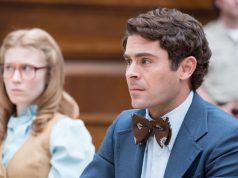Now that I’ve seen “The Brown Bunny,” I’m even more puzzled than before as to why Chloe Sevigny would agree to be in it. If he was being honest, this is all Vincent Gallo could have told her in his initial pitch:
“Hey, Chloe, I’ve got this movie that I wrote and that I’m going to direct, and there’s a perfect part for you! The movie’s gonna be really, really boring and pointless, with one scene after another of me driving a car and not saying anything, and it’s going to look really amateurish, and when the characters DO speak, their dialogue will sound contrived. So it will be a total waste of a film. And then, at the end, you come in and perform oral sex on me. And it won’t be faked; it will be you ACTUALLY performing oral sex on me. How’s that sound?”
And then for some reason Chloe Sevigny said yes. I have to assume her agent was not present.
Gallo plays a motorcycle racer named Bud Clay, a fact we learn when the film opens with two solid minutes of motorcycles driving around a racetrack, sans music, dialogue, opening credits or anything. (I’m told the Cannes version of this film, which was nearly 30 minutes longer, contained two MORE minutes of this.) After the race, he gets in his van and heads for California, apparently to see his girlfriend Daisy (Sevigny).
Bud has an unusual power over women. He convinces a gas station attendant to drive cross-country with him just by saying “please” a couple times (he then leaves without her while she’s packing), and at one point he stops at a rest area and makes out with a leathery woman who turns out to be Cheryl Tiegs, honest-to-goodness Cheryl Tiegs, who never says a word. Does he KNOW her? Or does he just walk up to strange women at rest stops and begin kissing them? You get the feeling Bud is the kind of man who could convince an attractive young actress to have sex with him in front of movie cameras. For example.
Anyway, he finally gets to California and reunites with Daisy for the sole purpose of berating her (she allegedly cheated on him), calling her filthy names, and getting a Lewinsky from her. This Bud is one charming fellow.
There is no craft here. Gallo, a bit-part actor and occasional director (“Buffalo ’66”), constructs “The Brown Bunny” so badly that it must have been intentional, though to what end I cannot imagine. He appears to have been imitating the low-budget indie films of an earlier era — I did occasionally think of “Easy Rider” — but without the underlying substance those movies usually had.
There is always either nothing happening, or else something is happening, but the camera is looking elsewhere. (The one exception is The Scene, when of course the camera makes sure to get right up close to the action.) Bud gets out of his van to go knock on someone’s door, for example, but the camera stays in the van, watching him from a distance. Or he’s driving, with the camera in the passenger seat watching him, but with most of his head cut out of the frame so we mostly just get the driver’s-side window. Many shots linger for several seconds after the subject has left the frame. There is almost no music. Bud hardly speaks. It is extraordinarily dull and tedious.
I must also mention Gallo’s hilariously bad acting in what is supposed to be Bud’s pivotal, emotional scene. He whimpers and mewls like a drama queen on the first day of acting school, making what is already an embarrassing moment — we just watched him violate Chloe Sevigny, after all — even more unwatchable.
What does it remind me of most? “Manos: The Hands of Fate,” the legendary film that the “Mystery Science Theater 3000” crew declared their most unbearable experiment ever. Both films were made cheap, look cheap, are badly framed, bubble with misogyny, and feature scene after endless scene of people driving.
The longer the film goes on, the more I hate it. If this is a “feature film,” then so are your old home movies, or videotapes from a convenience store’s security camera. You can praise it for being boldly deconstructionist, or for flouting the rules of cinema, or even for including a scene of hard-core pornography. But I denounce it for being the worst thing a movie can be: boring. It’s not just one scene; the whole movie blows.
F (1 hr., 31 min.; )





